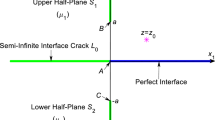Abstract
The magnetoelectroelastic solution of a generalized screw dislocation interacting with a wedge-shaped magnetoelectroelastic bi-material interface is derived in this paper. The screw dislocation is assumed to be straight and infinitely long in the z-direction and suffers a finite discontinuity in the displacement, electric potential and magnetic potential across the slip plane. The explicit closed-form analytical solution for the generalized stress field is derived by means of the complex variable and conformal mapping methods. The generalized stress intensity factors of the wedge tip induced by the dislocation and the image force acting on the dislocation are formulated and calculated. The influence of the wedge angle and the different bi-material constant combinations on the image force is discussed. Numerical examples for three particular wedge angles are calculated and compared with other available results.
Similar content being viewed by others
References
Bogy D.B., Wang K.C.: Stress singularities at interface corners in bonded dissimilar isotropic elastic materials. Int. J. Solids Struct. 7, 993–1005 (1971)
Chen D.H., Nisitani H.: Singular stress fields near the corner of jointed dissimilar materials. J. Appl. Mech. 60, 607–613 (1993)
Reedy E.D., Guess T.R.: Interface corner failure analysis of joint strength: effect of adherend stiffness. Int. J. Fract. 88, 305–314 (1997)
Reedy E.D.: Connection between interface corner and interfacial fracture analysis of an adhesively bonded butt joint. Int. Solids Struct. 37, 2429–2442 (2000)
Pahn L.O., Earmme Y.Y.: Analysis of a short interfacial crack from the corner of a rectangular inclusion. Int. J. Fract. 106, 341–356 (2000)
Nan C.W.: Magnetoelectric effect in composites of piezoelectric and piezomagnetic phase. Phys. Rev. B 50, 6082–6088 (1994)
Chung M.Y., Ting T.C.T.: The Green function for a piezoelectric piezomagnetic anisotropic elastic medium with an elliptic hole or rigid inclusion. Philos. Mag. Lett. 72, 405–410 (1995)
Wu T.L., Huang J.H.: Closed-form solutions for the magnetoelectric coupling coefficients in fibrous composites with piezoelectric and piezomagnetic phases. Int. J. Solids Struct. 37, 2981–3009 (2000)
Liu J.X., Liu X.L., Zhao Y.B.: Green’s functions for anisotropic magnetoelectro-elastic solids with an elliptical cavity or a crack. Int. J. Eng. Sci. 39, 1405–1418 (2001)
Pan E.: Exact solution for simply supported and multilayered magneto-electro-elastic plates. ASME J. Appl. Mech. 68, 608–618 (2001)
Wang X., Shen Y.P.: Inclusions of arbitrary shape in magnetoelectroelastic composite materials. Int. J. Eng. Sci. 41, 85–102 (2003)
Gao C.F., Tong P., Zhang T.Y.: Fracture mechanics for a mode III crack in a magnetoelectroelastic solid. Int. J. Solids Struct. 41, 6613–6629 (2004)
Fang Q.H., Liu Y.W., Jiang C.P.: On the interaction between a generalized screw dislocation and circular-arc interfacial rigid lines in magnetoelectroelastic solids. Int. J. Eng. Sci. 43, 1011–1031 (2005)
Hu K.Q., Li G.Q., Zhong Z.: Fracture of a rectangular piezoelectromagnetic body. Mech. Res. Commun. 33, 482–492 (2006)
Xiao Z.M., Chen B.J., Fan H.: An edge dislocation interacting with a wedge-shaped bi-material interface. Int. J. Solids Struct. 38, 8219–8233 (2001)
Chen B.J., Xiao Z.M., Liew K.M.: A piezoelectric screw dislocation near a wedge-shaped bi-material interface. Int. J. Solids Struct. 40(9), 2041–2056 (2003)
Muskhelishvili N.I.: Some Basic Problems of the Mathematical Theory of Elasticity. Noordhoff International Publishing, Leyden (1975)
Pak Y.E.: Force on a piezoelectric screw dislocation. ASME J. Appl. Mech. 57, 647–653 (1990)
Huang J.L., Liu K.H., Dai W.L.: The optimized fiber volume fraction for magnetoelectric coupling effect in piezoelectric-piezomagnetic continuous fiber reinforced composites. Int. J. Eng. Sci. 38, 1207–1217 (2000)
Author information
Authors and Affiliations
Corresponding author
Rights and permissions
About this article
Cite this article
Xiao, Z.M., Chen, B.J. & Luo, J. A generalized screw dislocation near a wedge-shaped magnetoelectroelastic bi-material interface. Acta Mech 214, 261–273 (2010). https://doi.org/10.1007/s00707-010-0286-9
Received:
Published:
Issue Date:
DOI: https://doi.org/10.1007/s00707-010-0286-9




